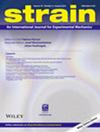用于详细研究承受爆炸载荷的能量吸收部件的实验装置
IF 1.8
3区 材料科学
Q2 MATERIALS SCIENCE, CHARACTERIZATION & TESTING
引用次数: 1
摘要
本文章由计算机程序翻译,如有差异,请以英文原文为准。
An experimental facility for detailed studies on energy absorbing components subjected to blast loading
Deformable components such as sandwich structures possess promising properties for use in protection systems. Detailed studies on energy absorption and fluid–structure interaction effects are necessary for the application of deformable sandwich structures in blast resistant design. In this paper, an existing shock tube facility has been extended with a transparent section to observe and measure fluid flow and the structural response of deformable components during transient dynamic loading. The extension was instrumented with pressure sensors and load cells to measure the pressure and force transmitted through the component during testing. The transparent design allows the use of optical measurement techniques. Here, high‐speed cameras were used both for digital image correlation and background‐oriented schlieren imaging. Tests with free‐standing plates and sandwich components were performed. A strong dependency was observed between the plate mass, and thus the velocity of the plates, and the pressure measured upstream and downstream of the components. The tests were simulated with a one‐dimensional numerical model for compressible shock flow with fluid–structure interaction. The numerical model accurately reproduced the shock flow and component displacements measured experimentally. Overall, the experimental set‐up presented in this study proved to be suitable for the detailed examination of deformable components subjected to airblast loading.
求助全文
通过发布文献求助,成功后即可免费获取论文全文。
去求助
来源期刊

Strain
工程技术-材料科学:表征与测试
CiteScore
4.10
自引率
4.80%
发文量
27
期刊介绍:
Strain is an international journal that contains contributions from leading-edge research on the measurement of the mechanical behaviour of structures and systems. Strain only accepts contributions with sufficient novelty in the design, implementation, and/or validation of experimental methodologies to characterize materials, structures, and systems; i.e. contributions that are limited to the application of established methodologies are outside of the scope of the journal. The journal includes papers from all engineering disciplines that deal with material behaviour and degradation under load, structural design and measurement techniques. Although the thrust of the journal is experimental, numerical simulations and validation are included in the coverage.
Strain welcomes papers that deal with novel work in the following areas:
experimental techniques
non-destructive evaluation techniques
numerical analysis, simulation and validation
residual stress measurement techniques
design of composite structures and components
impact behaviour of materials and structures
signal and image processing
transducer and sensor design
structural health monitoring
biomechanics
extreme environment
micro- and nano-scale testing method.
 求助内容:
求助内容: 应助结果提醒方式:
应助结果提醒方式:


